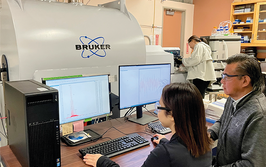Smells Like... Blood
Can the human nose beat analytical instrumentation when it comes to identifying gory components?
For predators, blood means food, and the scent alone is enough to trigger behavioral responses. Matthias Laska, professor of zoology at Linköping University in Sweden, wanted to identify the volatile compounds that give blood its “alluring” aroma.
“Very few people have analyzed the composition of blood odor – even in humans – except for finding biomarkers for certain diseases. It’s not an odor that’s commercially valuable; I think you have to be interested in animal behavior for this kind of study,” admits Laska, who sent a student to Andrea Büttner at the Friedrich-Alexander University in Erlangen, Germany, which specializes in the analysis of complex odors.

The volatile constituents of pig’s blood were isolated and the mixture was separated using gas chromatography. “There are hundreds of volatiles in blood odor, so identifying all the compounds is an enormous task,” explains Büttner. “Often it is the substances at very low concentrations that are the most potent, but they are difficult to detect with conventional detectors.” And so, the team chose to use a very specialized instrument: the human nose. “To this day, the human nose is more attentive and can detect lower concentrations of odorants,” says Laska.
Trained ‘sniffers’ sat at the outlet of the GC and were able to pinpoint the peaks of most interest. Several odorants were identified in the blood samples, one of which was very potent: the metallic smell of trans-4,5-epoxy-(E)-2-decenal.
“We used the hypothesis that we humans might be able to smell the same substance as the predators,” says Büttner. “I had a gut feeling from my daily sniffing experience that this was a promising substance that might be a potent trigger for the smell of blood.”
Laska infused logs with trans-4,5-epoxy-(E)-2-decenal and presented them to animals (1). “The animals performed better than even in our wildest dreams,” he says. “They clearly reacted to the infused logs – sniffing, licking, pawing and toying. It will be interesting to continue this line of research to see how this has evolved.”
When it comes to practical uses, Laska says that presenting odorant objects to carnivores in captivity can be useful for environmental enrichment. The next step of the study will be to present the substance to other animals, such as prey species.
“I would assume from the development of smell and its genetic base that all mammals react to similar compounds,” says Büttner. “For me, it’s also important to do further identification and quantification on all the other odorants we detected. I would like to see if this whole bouquet of blood smells works better than the trans-4,5-epoxy-(E)-2-decenal.”
- S. Nilson et al., “Behavioral Responses to Mam malian Blood Odor and a Blood Odor Component in Four Species of Large Carnivores”, PLOS One (2014). DOI: 10.1371/journal.pone.0112694

"Making great scientific magazines isn’t just about delivering knowledge and high quality content; it’s also about packaging these in the right words to ensure that someone is truly inspired by a topic. My passion is ensuring that our authors’ expertise is presented as a seamless and enjoyable reading experience, whether in print, in digital or on social media. I’ve spent seven years writing and editing features for scientific and manufacturing publications, and in making this content engaging and accessible without sacrificing its scientific integrity. There is nothing better than a magazine with great content that feels great to read."

















